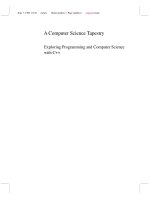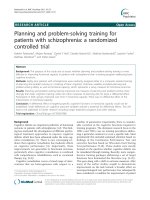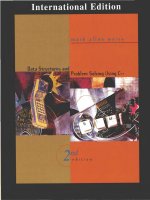programming and problem solving with c++ 6th by dale ch04
Bạn đang xem bản rút gọn của tài liệu. Xem và tải ngay bản đầy đủ của tài liệu tại đây (695.41 KB, 69 trang )
Chapter 4
Program Input and the
Software Design Process
Chapter 4 Topics
Input Statements to Read Values into a
Program using >>, and functions get,
ignore, getline
Prompting for Interactive Input/Output
(I/O)
Using Data Files for Input and Output
Chapter 4 Topics
Object-Oriented Design Principles
Functional Decomposition Methodology
Software Engineering Tip Documentation
C++ Input/Output
No built-in I/O in C++
A library provides input stream and
output stream
Keyboard
Screen
executing
program
istream
ostream
<iostream> Header File
Access to a library that defines 3
objects
An istream object named cin (keyboard)
An ostream object named cout (screen)
An ostream object named cerr (screen)
Giving a Value to a Variable
In your program you can assign (give) a value to the
variable by using the assignment operator =
ageOfDog = 12;
or by another method, such as
cout << “How old is your dog?”;
cin >> ageOfDog;
>> Operator
>> is called the input or extraction operator
>> is a binary operator
>> is left associative
Expression
Has value
cin >> age
cin
Statement
cin >> age >> weight;
Extraction Operator (>>)
Variable cin is predefined to denote an input
stream from the standard input device((the
keyboard)
The extraction operator >> called “get
from” takes 2 operands; the left operand is
a stream expression, such as cin--the right
operand is a variable of simple type
Extraction Operator (>>)
Operator >> attempts to extract (inputs)
the next item from the input stream and to
store its value in the right operand variable
>> “skips over” (actually reads but does
not store anywhere) leading white space
characters as it reads your data from the
input stream(either keyboard or disk file)
Input Statements
SYNTAX
cin >> Variable >> Variable . . .;
These examples yield the same result.
cin >> length;
cin >> width;
cin >> length >> width;
Whitespace Characters Include . . .
blanks
tabs
end-of-line (newline) characters
newline character created by:
hitting
Enter or Return at the keyboard
or
by using the manipulator endl or by
using the symbols "\n" in the program
At keyboard you type:
A[space]B[space]C[Enter]
char first;
char middle;
char last;
cin >> first ;
cin >> middle ;
cin >> last ;
first
middle
last
‘A’
‘B’
‘C’
first
middle
last
NOTE: A file reading marker is left pointing to the
newline character after the ‘C’ in the input stream
At keyboard you type:
[space]25[space]J[space]2[Enter]
int age;
char initial;
float bill;
age
initial
bill
25
‘J’
2.0
cin >> age;
cin >> initial;
cin >> bill;
age
initial
bill
NOTE: A file reading marker is left pointing to the
newline character after the 2 in the input stream
Keyboard and Screen I/O
#include <iostream>
output data
input data
executing
program
Keyboard
cin
(of type istream)
Screen
cout
(of type ostream)
Another example using >>
NOTE:
shows the location of the file reading marker
STATEMENTS
CONTENTS
MARKER
POSITION
int
i;
char ch;
float x;
cin >> i;
cin >> ch;
cin >> x;
25 A\n
16.9\n
i
ch
x
25
i
ch
25
‘A’
x
i
ch
x
25
‘A’
16.9
i
ch
x
25 A\n
16.9\n
25 A\n
16.9\n
25 A\n
16.9\n
Another Way to Read char
Data
• The
get() function can be used to
read a single character.
•get() obtains the very next
character from the input stream without
skipping any leading whitespace
characters
At keyboard you type:
A[space]B[space]C[Enter]
char first;
char middle;
char last;
cin.get(first);
cin.get(middle);
cin.get(last);
first
middle
last
‘A’
‘’
‘B’
first
middle
last
NOTE: The file reading marker is left pointing to the
space after the ‘B’ in the input stream
17
Use function ignore()
to skip characters
The ignore() function is used to skip (read and
discard) characters in the input stream
The call:
cin.ignore(howMany, whatChar);
will skip over up to howMany characters or until
whatChar has been read, whichever comes first
An Example Using cin.ignore()
NOTE:
shows the location of the file reading marker
STATEMENTS
CONTENTS
MARKER
POSITION
int
a;
int
b;
int
c;
cin >> a >> b;
cin.ignore(100, ‘\n’);
cin >> c;
a
b
c
957
34
a
b
957
34
a
b
c
957
34
128
a
b
c
c
957 34 1235\n
128 96\n
957 34 1235\n
128 96\n
957 34 1235\n
128 96\n
957 34 1235\n
128 96\n
Another Example Using cin.ignore()
NOTE:
shows the location of the file reading marker
STATEMENTS
CONTENTS
MARKER
POSITION
int
i;
char ch;
cin >> ch;
cin.ignore(100, ‘B’);
cin >> i;
A 22 B 16 C 19\n
i
ch
957
i
‘A’
34
ch
957
34
‘A’
i
ch
957
16
34
‘A’
i
ch
A 22 B 16 C 19\n
A 22 B 16 C 19\n
A 22 B 16 C 19\n
String Input in C++
Input of a string is possible using the
extraction operator >>
Example
string message;
cin >> message;
Cout << message;
However . . .
>> Operator with Strings
Using the extraction operator(>>) to read
input characters into a string variable
The >> operator skips any leading
whitespace characters such as blanks and
newlines
It then reads successive characters into the
string
>> operator then stops at the first trailing
whitespace character (which is not
consumed, but remains waiting in the input
stream)
String Input Using >>
string firstName;
string lastName;
cin >> firstName >> lastName;
Suppose input stream looks like this:
Joe Hernandez
23
What are the string values?
Results Using >>
string firstName;
string lastName;
cin >> firstName >> lastName;
Result
“Joe”
“Hernandez”
firstName
lastName
getline() Function
Because the extraction operator stops
reading at the first trailing whitespace, >>
cannot be used to input a string with
blanks in it
Use the getline function with 2
arguments to overcome this obstacle
First argument is an input stream variable,
and second argument is a string variable
Example
string message;
getline(cin, message);









